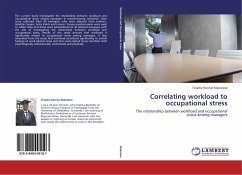Occupational Psychology: An Applied Approach introduces students to the essential key theories in this area, from motivation and well-being to group roles and individual differences. The book explores the impact of every topic from the perspective of the individual, management, and the organisation as a whole, encouraging the reader to consider the consultancy process at each stage. Written in a clear and concise style, with an emphasis on the application of these theories and skills in the real world, readers can use this book to move beyond theory and into practice.
Product Description
Occupational Psychology: An Applied Approach introduces you to the essential key theories in this area, from motivation and well-being to group roles and individual differences. The book explores the impact of every topic from the perspective of the individual, management, and the organisation as a whole, encouraging you to consider the consultancy process at each stage.
Features + Benefits
A focus on employability throughout emphasizes the relevance of occupational psychology to everyday experiences of work
Each chapter features a fictional case study, allowing readers to put their skills into practice
Real case examples highlight the application of theory in the context of actual organisations
Reflective questions and Questions for thought help to reinforce learning by encouraging readers to engage with the theory
Short answer questions at the end of each chapter allow students to check their understanding
Backcover
“A book that should be on the shelves of all aspiring Occupational Psychologists.” Bridget Hanna, Chartered Psychologist, Glasgow Caledonian University
‘…a welcome addition for students of Occupational Psychology, this is an immensely readable and informative account of most of the issues facing Occupational Psychologists today…it offers plenty of opportunity to engage with the material whilst not compromising on depth of information.’ Dr Sandi Mann, University of Central Lancashire
Occupational Psychology: An Applied Approach introduces students to the essential key theories in this area, from motivation and well-being to group roles and individual differences. The book explores the impact of every topic from the perspective of the individual, management, and the organisation as a whole, encouraging the reader to consider the consultancy process at each stage. Written in a clear and concise style, with an emphasis on the application of these theories and skills in the real world, readers can use this book to move beyond theory and into practice.
Key features:
Each chapter features a fictional case study, allowing readers to put their skills into practice
Real case examples highlight the application of theory in the context of actual organisations
Reflective questions and Questions for thought help to reinforce learning by encouraging readers to engage with the theory
Short answer questions at the end of each chapter allow students to check their understanding
A focus on employability throughout emphasizes the relevance of occupational psychology to everyday experiences of work
Both practical and theoretical, this is a book that will equip students with a complete and applied understanding of the area.
Gail Steptoe-Warren is Senior Lecturer and Course Director in Occupational Psychology at Coventry University
Preface
Acknowledgements
List of contributors
Guided tour
Publisher’s acknowledgements
1. Introduction to occupational psychology
Learning outcomes
1.1 Introduction
1.2 Occupational psychology in the pre-First World War era
1.3 Occupational psychology in the First World War
1.4 Post-First World War and pre-Second World War
1.5 Occupational psychology in the Second World War
1.6 Occupational psychology in the 1940s to 1960s
1.7 Occupational psychology from the 1970s to the present
1.8 Challenges for occupational psychology in the 21st century
1.9 Conclusions
Short-answer questions
Further reading
2. Becoming a practitioner occupational psychologist and the consultancy cycle
Learning outcomes
2.1 Becoming a practitioner occupational psychologist
2.2 Consultancy
2.3 The consultancy cycle
2.4 Writing a business/consultancy report
2.5 Ethics
2.6 Conclusions
Short-answer questions
Websites
Further reading
3. Legislation applied to the workplace
Learning outcomes
3.1 Introduction
3.2 United Kingdom law
3.3 European law
3.4 Types of discrimination
3.5 Protected characteristics
3.6 Avoiding discrimination
3.7 Summary
Short-answer questions
Websites
Further information
4. Personnel selection and assessment
Learning outcomes
4.1 Introduction
4.2 Job analysis
4.3 Job description
4.4 Person specification
4.5 Job advertisements
4.6 Selection process
4.7 Fairness in selection
4.8 Decision-making
Multi-level impact of personnel selection and assessment
Legal context
Short-answer questions
Case study: Personnel selection and assessment
Further reading
5. Performance appraisal, career development, counselling and coaching
Learning outcomes
5.1 Introduction
5.2 Performance appraisal
5.3 Career development, counselling and coaching
Multi-level impact of performance appraisal and career development
Legal context
Short-answer questions
Case study: Performance appraisal and career development/counselling
Further reading
6. Well-being, stress and work-–life balance
Learning outcomes
6.1 Introduction
6.2 Well-being
6.3 Stress at work
6.4 Causes of stress at work
6.5 Consequences of stress
6.6 Outcomes of stress reduction
6.7 Healthy workplace
Multi-level impact of stress
Legal context
Short-answer questions
Case study: Well-being, stress and work–life balance
Further information
7. Individual differences
Learning outcomes
7.1 Introduction
7.2 Personality
7.3 Intelligence
7.4 Values, individual beliefs and behaviour
Multi-level impact of individual differences
Legal context
Short-answer questions
Case study: Individual differences
Further reading
8. Training
Learning outcomes
8.1 Introduction
8.2 Models of training
8.3 Training
8.4 Benefits of training
Multi-level impact of training
Legal context
Short-answer questions
Case study: Training
Further reading
9. Design of environments and work
Learning outcomes
9.1 Introduction
9.2 Categories of ergonomics
9.3 Health issues
9.4 Risk assessment
9.5 Human error
9.6 Error management
Multi-level impact of ergonomics
Legal context
Short-answer questions
Case study: Design of environments and work
10. Motivation, job satisfaction, employee engagement and behaviour modification
Learning outcomes
10.1 Introduction
10.2 Motivation
10.3 Job design theories
10.4 Managing motivation within organisations
10.5 Job satisfaction
10.6 Measurement of job satisfaction
10.7 Managing job satisfaction within organisations
10.8 Employee engagement
10.9 Behaviour modification
Multi-level impact of motivation, job satisfaction and employee engagement
Legal context
Short-answer questions
Case study: Motivation, job satisfaction and employee engagement
Further reading
11. Management and leadership approaches
Learning outcomes
11.1 Introduction
11.2 Theories of leadership
11.3 Management theories
11.4 Modern concept of leadership
11.5 Leadership development
Multi-level impact of leadership
Legal context
Short-answer questions
Case study: Management and leadership
Further reading
12. Groups and teams
Learning outcomes
12.1 Introduction
12.2 Definitions of groups and teams
12.3 Function of work groups and teams in organisations
12.4 Formation and development of groups
12.5 Defining group development
12.6 Group roles
12.7 Group factors and group performance
Legal context
Short-answer questions
Case study: Groups and teams
13. Organisational structures, culture and change
Learning outcomes
13.1 Introduction
13.2 Organisational structures
13.3 Organisational culture
13.4 Organisational change
Multi-level impact of organisational structures, culture and change
Legal context
Short-answer questions
Case study: Organisational change
Further reading
14. Example consultancy reports
14.1 Introduction
14.2 The case of Sammie Services: from Chapter 4 - Personnel selection and assessment
14.3 The case of Sammie Printing Supplies: from Chapter 13 - Organisational structures, culture and change
Weblinks
15. The future of work
Learning outcomes
15.1 Introduction
15.2 Organisational changes
15.3 Team/individual changes
Multi-level impact of the future of work
Weblinks
Glossary
References
Index
Occupational Psychology: An Applied Approach introduces students to the essential theories in this area, from motivation and wellbeing to group roles and individual differences. The book explores the impact of every topic from the perspective of the individual, management, and the organisation as a whole, encouraging the reader to consider the consultancy process at each stage.
Hinweis: Dieser Artikel kann nur an eine deutsche Lieferadresse ausgeliefert werden.
Product Description
Occupational Psychology: An Applied Approach introduces you to the essential key theories in this area, from motivation and well-being to group roles and individual differences. The book explores the impact of every topic from the perspective of the individual, management, and the organisation as a whole, encouraging you to consider the consultancy process at each stage.
Features + Benefits
A focus on employability throughout emphasizes the relevance of occupational psychology to everyday experiences of work
Each chapter features a fictional case study, allowing readers to put their skills into practice
Real case examples highlight the application of theory in the context of actual organisations
Reflective questions and Questions for thought help to reinforce learning by encouraging readers to engage with the theory
Short answer questions at the end of each chapter allow students to check their understanding
Backcover
“A book that should be on the shelves of all aspiring Occupational Psychologists.” Bridget Hanna, Chartered Psychologist, Glasgow Caledonian University
‘…a welcome addition for students of Occupational Psychology, this is an immensely readable and informative account of most of the issues facing Occupational Psychologists today…it offers plenty of opportunity to engage with the material whilst not compromising on depth of information.’ Dr Sandi Mann, University of Central Lancashire
Occupational Psychology: An Applied Approach introduces students to the essential key theories in this area, from motivation and well-being to group roles and individual differences. The book explores the impact of every topic from the perspective of the individual, management, and the organisation as a whole, encouraging the reader to consider the consultancy process at each stage. Written in a clear and concise style, with an emphasis on the application of these theories and skills in the real world, readers can use this book to move beyond theory and into practice.
Key features:
Each chapter features a fictional case study, allowing readers to put their skills into practice
Real case examples highlight the application of theory in the context of actual organisations
Reflective questions and Questions for thought help to reinforce learning by encouraging readers to engage with the theory
Short answer questions at the end of each chapter allow students to check their understanding
A focus on employability throughout emphasizes the relevance of occupational psychology to everyday experiences of work
Both practical and theoretical, this is a book that will equip students with a complete and applied understanding of the area.
Gail Steptoe-Warren is Senior Lecturer and Course Director in Occupational Psychology at Coventry University
Preface
Acknowledgements
List of contributors
Guided tour
Publisher’s acknowledgements
1. Introduction to occupational psychology
Learning outcomes
1.1 Introduction
1.2 Occupational psychology in the pre-First World War era
1.3 Occupational psychology in the First World War
1.4 Post-First World War and pre-Second World War
1.5 Occupational psychology in the Second World War
1.6 Occupational psychology in the 1940s to 1960s
1.7 Occupational psychology from the 1970s to the present
1.8 Challenges for occupational psychology in the 21st century
1.9 Conclusions
Short-answer questions
Further reading
2. Becoming a practitioner occupational psychologist and the consultancy cycle
Learning outcomes
2.1 Becoming a practitioner occupational psychologist
2.2 Consultancy
2.3 The consultancy cycle
2.4 Writing a business/consultancy report
2.5 Ethics
2.6 Conclusions
Short-answer questions
Websites
Further reading
3. Legislation applied to the workplace
Learning outcomes
3.1 Introduction
3.2 United Kingdom law
3.3 European law
3.4 Types of discrimination
3.5 Protected characteristics
3.6 Avoiding discrimination
3.7 Summary
Short-answer questions
Websites
Further information
4. Personnel selection and assessment
Learning outcomes
4.1 Introduction
4.2 Job analysis
4.3 Job description
4.4 Person specification
4.5 Job advertisements
4.6 Selection process
4.7 Fairness in selection
4.8 Decision-making
Multi-level impact of personnel selection and assessment
Legal context
Short-answer questions
Case study: Personnel selection and assessment
Further reading
5. Performance appraisal, career development, counselling and coaching
Learning outcomes
5.1 Introduction
5.2 Performance appraisal
5.3 Career development, counselling and coaching
Multi-level impact of performance appraisal and career development
Legal context
Short-answer questions
Case study: Performance appraisal and career development/counselling
Further reading
6. Well-being, stress and work-–life balance
Learning outcomes
6.1 Introduction
6.2 Well-being
6.3 Stress at work
6.4 Causes of stress at work
6.5 Consequences of stress
6.6 Outcomes of stress reduction
6.7 Healthy workplace
Multi-level impact of stress
Legal context
Short-answer questions
Case study: Well-being, stress and work–life balance
Further information
7. Individual differences
Learning outcomes
7.1 Introduction
7.2 Personality
7.3 Intelligence
7.4 Values, individual beliefs and behaviour
Multi-level impact of individual differences
Legal context
Short-answer questions
Case study: Individual differences
Further reading
8. Training
Learning outcomes
8.1 Introduction
8.2 Models of training
8.3 Training
8.4 Benefits of training
Multi-level impact of training
Legal context
Short-answer questions
Case study: Training
Further reading
9. Design of environments and work
Learning outcomes
9.1 Introduction
9.2 Categories of ergonomics
9.3 Health issues
9.4 Risk assessment
9.5 Human error
9.6 Error management
Multi-level impact of ergonomics
Legal context
Short-answer questions
Case study: Design of environments and work
10. Motivation, job satisfaction, employee engagement and behaviour modification
Learning outcomes
10.1 Introduction
10.2 Motivation
10.3 Job design theories
10.4 Managing motivation within organisations
10.5 Job satisfaction
10.6 Measurement of job satisfaction
10.7 Managing job satisfaction within organisations
10.8 Employee engagement
10.9 Behaviour modification
Multi-level impact of motivation, job satisfaction and employee engagement
Legal context
Short-answer questions
Case study: Motivation, job satisfaction and employee engagement
Further reading
11. Management and leadership approaches
Learning outcomes
11.1 Introduction
11.2 Theories of leadership
11.3 Management theories
11.4 Modern concept of leadership
11.5 Leadership development
Multi-level impact of leadership
Legal context
Short-answer questions
Case study: Management and leadership
Further reading
12. Groups and teams
Learning outcomes
12.1 Introduction
12.2 Definitions of groups and teams
12.3 Function of work groups and teams in organisations
12.4 Formation and development of groups
12.5 Defining group development
12.6 Group roles
12.7 Group factors and group performance
Legal context
Short-answer questions
Case study: Groups and teams
13. Organisational structures, culture and change
Learning outcomes
13.1 Introduction
13.2 Organisational structures
13.3 Organisational culture
13.4 Organisational change
Multi-level impact of organisational structures, culture and change
Legal context
Short-answer questions
Case study: Organisational change
Further reading
14. Example consultancy reports
14.1 Introduction
14.2 The case of Sammie Services: from Chapter 4 - Personnel selection and assessment
14.3 The case of Sammie Printing Supplies: from Chapter 13 - Organisational structures, culture and change
Weblinks
15. The future of work
Learning outcomes
15.1 Introduction
15.2 Organisational changes
15.3 Team/individual changes
Multi-level impact of the future of work
Weblinks
Glossary
References
Index
Occupational Psychology: An Applied Approach introduces students to the essential theories in this area, from motivation and wellbeing to group roles and individual differences. The book explores the impact of every topic from the perspective of the individual, management, and the organisation as a whole, encouraging the reader to consider the consultancy process at each stage.
Hinweis: Dieser Artikel kann nur an eine deutsche Lieferadresse ausgeliefert werden.








